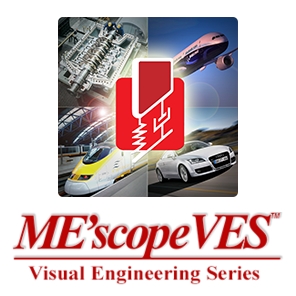
VT-540 Visual SDM™
The Visual SDM™ package combines all of the features of theVisual Modal™ package with the features of the VES-5000 Structural Dynamics Modification option.
Once you have identified and quantified a resonance problem in a machine or structure, the next question is, “How can the structure be modified to fix the problem?”
Visual SDM™ helps you quickly evaluate alternative solutions to resonance problems by adding additional tools to the modal analysis features of a Visual Modal™ package. The Structural Dynamics Modification (SDM) method allows you to examine the effects of a variety of potential structural modifications on the resonances of a structure without actually having to make the physical modifications.
The resonances (modes of vibration) of a machine or structure depend on its physical properties (geometry, density, elasticity, boundary conditions, etc.). Changing the physical properties of a structure by adding modifications such as stiffeners, brackets, tuned absorbers or other modifications, will directly affect its modes. The SDM method uses industry standard finite elements such as springs, masses, dampers, bars, plates, and solids to model the modifications. These modifications, together with the modes of the original (unmodified) structure, are used to calculate the new modes of the modified structure.
In the example shown below, a stiffener was added across the bottom of an aluminum panel. Adding the stiffener replaced the first mode of the structure (a bending mode at 73Hz) with a torsional mode at 94Hz. The torsional mode was the second mode of the original structure but was not affected by the rib stiffener. Without the added stiffener, machinery in the vicinity operating at 4000-4500 RPM would excite the first bending mode of this panel causing it to resonate. Adding the stiffener not only eliminated the mode at 73Hz, but also eliminated another mode at 143Hz, thus removing a potential resonance problem at 2X RPM as well.
VT-540 Visual SDM™
Structural Dynamics Modification Features:
- Interactive graphical addition of structural modification elements to a structure model
- All visible FEA elements on a structure model are used by SDM. All hidden elements are ignored
- Modifications can be modeled using the following FEA elements; Point masses, linear springs and linear dampers, rod and beam elements, triangular and quadrilateral plate elements, tetrahedrons, prisms, and brick solid elements
- All finite element properties are displayed and edited in property spreadsheets
- Modal sensitivity analysis. Define a solution space of FEA properties, and calculate new modes that minimize differences with target modal properties
- Sub-structuring. Two or more substructures can be connected together with FEA elements, and the modes of the combined substructures calculated
- Tuned absorbers. Multiple mass-spring-damper vibration absorbers can be attached to a structure model, and the new modes of the structure calculated
Modal Analysis Features:
- Mode Indicators for counting modes. Either a Complex Mode Indicator Function (CMIF) or a Multivariate Mode Indicator Function (MMIF) can be calculated, and all resonance peaks are counted above a scrollable noise threshold
- Frequency & damping curve fitting. Either the Local or theGlobal MDOF Orthogonal Polynomial method can be used, with extra polynomial terms to compensate for out-of-band modes
- Residue curve fitting. Either the MDOF Orthogonal Polynomial method or the SDOF Peak cursor method can be used
- Quick Fit. Automatically executes all three curve fitting steps with minimal user interaction
- Frequency & damping estimates are graphically indicated on the Mode Indicator graph
- A curve fit function is synthesized and overlaid on each measurement to graphically confirm each curve fit
- Selected measurements and frequency bands can be used to improve modal parameter estimates
- All modal parameter estimates and curve fitting functions are saved with each measurement
- FRFs can be synthesized using modal parameters
- Modal Assurance Criterion (MAC). A bar graph and spreadsheet of the MAC values between all mode shape pairs. If MAC = 1, two shapes are the same. If MAC < 0.9 two shapes are different.
- Shape Difference Indicator (SDI). A bar graph and spreadsheet of the SDI values between all mode shape pairs. If SDI = 1, two shapes have the same values. If SDI < 0.9 two shapes have different values
- Modal Participation. Displays the Real part, Imaginary part, and Magnitude of the modal participation factors that result when a set of shapes is curve fit to another set of shapes.
Product Documentation